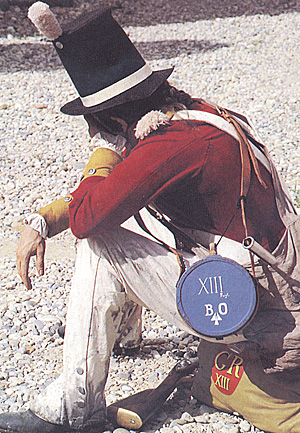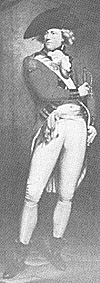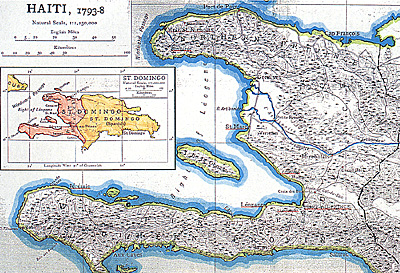 T.D. Hooker's article on San Domingo in issue 10 of
Napoleonic Notes and Queries provided a useful outline survey of
that campaign [albeit omitting mention of the Bombarde disaster on
1st May 17941, but in relying rather too heavily on Fortescue's
inaccurate and indeed somewhat biased account, and failing to take
account of more recent research, he has perhaps inadvertantly
perpetuated one or two of the hoarier myths.
T.D. Hooker's article on San Domingo in issue 10 of
Napoleonic Notes and Queries provided a useful outline survey of
that campaign [albeit omitting mention of the Bombarde disaster on
1st May 17941, but in relying rather too heavily on Fortescue's
inaccurate and indeed somewhat biased account, and failing to take
account of more recent research, he has perhaps inadvertantly
perpetuated one or two of the hoarier myths.
British 13th Foot in Tropical Kit created by Gary Embleton's Time Machine AG
While there is no doubting the fearful mortality experienced by British troops on the island, anyone who is acquainted with the state of the surviving district and regimental returns in the PRO will testify that Fortescue goes too far in claiming that some record were deliberately destroyed in order to hide the facts. There was, as someone is bound to have remarked at the time, a war on, and the survival of documents [assuming that they were ever compiled in the first place], is simply a rather hit and miss affair -- if anyone has come across the Inspection reports on 1/Royals for 1792 or 1793, I'd be glad to hear from them. They certainly aren't filed where they should be - and that was in peacetime!
As for that particular regiment, it is also quite misleading to state that 1/Royals were "already down to a strength of only 400 men," when they were despatched from Jamaica.
In actual fact when they originally sailed from Cork for Jamaica on the 20th of January 1790 they embarked only 349 effectives out of what was then the official establishment of 370 the remaining twenty-one being left behind to form a depot. Subsequent alterations to the official establishment over the next four years simply reflected short term Treasury policy and bore no relationship whatsoever to the actual situation on the ground.
Thus, although the outbreak of war with France at the beginning of 1793 saw the establishment increased at the stroke of a pen to 850 rank and file, the Royals could still only muster 355 men on the 1st January 1794. In other words, despite a serious outbreak of fever in 1792 they had more or less successfully maintained their original 1790 establishment, but not surprisingly they had been quite unable to produce the 500 new recruits so suddenly and arbitrarily added to their establishment at the beginning of the previous year.
Nor, as Fortescue reports, were they sent to San Domingo in December 1793. It actually took them quite some time to get there. The first to go were the two flank companies; on the I st February 1794 Captains Morshead and Stone, and Lieutenants Duncan, McKellar and Urquhart were returned as 'on command' at Port Royal, about to sail with the next wave of reinforcements for the island. Men from the battalion companies must have been drafted in to bring the grenadiers and light infantry up to sixty men apiece for this expedition since they accounted between them for a quarter of the battalion's strength in April and May.
The flank companies took part in the storming of L'Acul, near Leogane, on the l9th of February, and the light company then formed part of its garrison, while the grenadiers only then went across to reinforce the garrison of the Mole St. Nicholas. Two further divisions [double companies] of the regiment, commanded by Captains William Duncan and John Clayton Cowell joined the troops at Leogane shortly afterwards, while a third division led by Major Justly Watson Green, the battalion's acting commanding officer landed at I'Archahaye sometime in March. The remaining division, led by Lieutenant John Puxley only arrived at the Mole sometime between the 19th and the 30th of April.
No attempt was made to bring the various detachments
together until the attack on Port au Prince at the beginning of June
and even then Puxley's division was still left in garrison at the
Mole, [which was otherwise stripped, not reinforced] the
grenadiers were still incorporated in the provisional 'Flank
Battalion' and other minor detachments were scattered all over the
island, some of them forming training teams attached to Colonial
units. Lieutenant Urquhart and Sergeant Allan for example although
nominally on the strength of the grenadier company, remained at
the Mole St. Nicholas attached to Contades' Legion, otherwise
known as the Gendarmes Royaux Anglais.
[1]
Describing these colonial units as being made up of black
and mulatto troops is rather simplistic. Although the British Army
did sponsor some black/mulatto units, most colonial units fell into three categories:
The Marechausee, which was a pre-war para-military
police force made up of mulattoes. Detatchments served with most
garrisons.
Chasseurs, who were black slaves formed in ranger units
led by white officers [usually French], and; Legions, which were
all-white units, and notwithstanding their generally well deserved
reputation for corruption, the largest of the colonial units. On the
1st of July 1795 for example, the splendidly wicked de
Montalambert's all-white 'British Legion' mustered: 131 Infantry
69 Artillery, 89 Hussars [with 33 fit horses] 55 Chevaux Leger
[with 12 fit horses]
This compares quite favourably with the 126 rank and file
[besides 137 sick and convalescent] mustered on the same date by
1/Royals, always one of the stronger regular units.
Contades' Legion, reputedly the most corrupt of the lot,
had an establishment of 300 infantry and 300 cavalry, but on the
8th of December could muster only 185 white infantry and 20
white cavalry. [2]
Again, however, this compares reasonably well with the
121 fit and 101 sick or convalescent mustered by I/Royals a week
earlier, particularly when the dispersed state of the regular
battalion is also taken into account.
The campaign on San Domingo is certainly worth
studying, though much information still lies in the PRO. Two
excellent books, however, are essential reading, though neither,
regrettably, are cited by Mr. Hooker;
Thomas Howard: The Haitian Journal of Lieutenant
Howard, York Hussars. [Ed. R.N. Buckley] Univ. of Tennessee
1985 available from Caliver Books. The latter is a useful eyewitness account of campaigning
on San Domingo towards the end of the campaign, although the
editor's fervent attempts to attribute politically correct feelings to
the subject are both inappropriate and irritating.
Another volume worth obtaining, albeit perhaps with some
difficulty - but certainly worth the effort - , is Marcus Rainsford's
'An Historical Account of the Black Empire of Hayti' (London
1805). Similarly Bryan Edwards' 'Historical Survey of the Island of
St. Domingo' (London 1797 and 1801) is another important
contemporary account - failing this one try to get his three volume
'History of the West Indies' in which it is also incorporated.
A fair amount of military detail can also be gained from the
official despatches in the London Gazette (ZJ1 sequence in the
PRO), though these are restricted to successes such as the taking of
Port au Prince and remarkably silent on set-backs such as the
Bombarde debacle.
Our thanks to the National Army Museum for permission
to use a portrait in their collection and photos from the 'Road to
Waterloo' exhibition to accompany this article.
 Captain John Clayton Cowell, 1/Royals 1795. This
portrait was painted shortly after his departure from San Domingo
on what turned out to be indefinite leave. Nevertheless his soldier
servant in the background still wears the distinctive 'American'
trousers worn by British troops in the Caribbean. (National Army
Museum)
Captain John Clayton Cowell, 1/Royals 1795. This
portrait was painted shortly after his departure from San Domingo
on what turned out to be indefinite leave. Nevertheless his soldier
servant in the background still wears the distinctive 'American'
trousers worn by British troops in the Caribbean. (National Army
Museum)
David Geggus: Slavery, War and Revolution: The British
Occupation of Saint Domingue 1793-1798 [OUP 1982)
Notes
[1] All information relating to the
strength, dispositions and movements of 1/Royals on San Domingo, is drawn
from: WO 12 1883 muster rolls, WO 17 95 monthly states, WO 17 1986 district
returns.
[2]Documention relating to Contades'
Legion and other colon units can be found in:
W01/60-63 San Domingo - Governor's dispatches.

Jumbo Map of Haiti (monstrously slow: 544K)
Back to Napoleonic Notes and Queries #12 Table of Contents
Back to Age of Napoleon List of Issues
Back to MagWeb Master List of Magazines
© Copyright 1993 by Partizan Press.
This article appears in MagWeb.com (Magazine Web) on the Internet World Wide Web.
Other articles from military history and related magazines are available at http://www.magweb.com